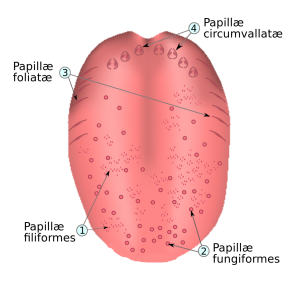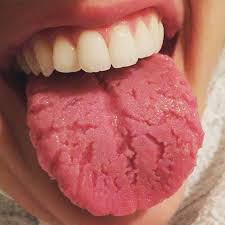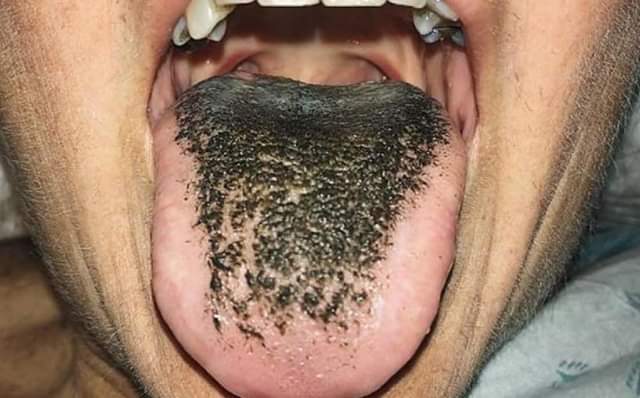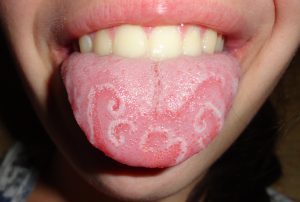How To Remove Plaque From Tongue? Tongue Cleaners
Learning How To Remove Plaque From Tongue will help us decrease the bacteria in the mouth leading to freshen breath and may help us begin to deal with the above issues.
Why Should Learn How To Remove Plaque From Tongue
Did you know that an average of 60-80% of Dental Plaque and bacteria is located on your tongue alone?
Are you wondering why you end up tasting bad breath everyday even though you brush and floss daily as well as see your Dental Provider every 6 months.
Did you know that cleaning your tongue properly will improve your overall taste buds because you’re removing clogged pappillae.
The white coating of bacteria on your tongue causes chronic bad breath (halitosis), and can make conditions of Gingivitis, Cavities, and Periodontal disease progress.
Because the surface area of the tongue can be very large, it has the capacity to harbor Food debris and plaque bacteria. Because These odor-causing bacteria get trapped under the surface of your tongue, it can cause a foul odor in your mouth called Halitosis.
Warning: Before getting a tongue scraper, and scraping away everything on your tongue, please consult your Dentist or Doctor to confirm that you actually have Plaque on your tongue and it is not actually just your anatomy.
How To Remove Plaque From Tongue properly?
- Brush your Tongue with your toothbrush
- Lightly scrape your tongue with a tongue scraper reaching as far back behind the circumvallate pappillae.
- Finish up with mouthwash to moisten the tongue to avoid a dry mouth and tongue which can lead to bad breath.
- Make sure to drink water throughout the day in order to flush the left over food particles from your cheeks, tongue and vestibules. Remember: a dry mouth is a stank mouth.
There are a couple ways to remove plaque from your tongue, and those ways are brushing, scraping with a tongue scraper as well as mouthwash.
How do I clean my tongue properly with a Toothbrush?
Brush your tongue after you brush your teeth, and spit out the excess toothpaste. You want to use your toothbrush bristles to lightly scrub the top surface of your tongue in a forwards / backwards motion, side to side motion, as well as in little circles. Be sure to get back to the Circumvallate Papilla which is at the back of the tongue near the throat.
Try to be extremely careful when scrubbing this area because many times, I have hit the back of my throat, hit a tooth with my toothbrush, as well as induced the gag reflex on myself. It’s ok if you accidentally gag yourself while brushing the back of your tongue because it’s important to remove the plaque from the back surface of your tongue.
When you are brushing your tongue, don’t forget to lightly brush the roof of your mouth as well as your cheeks because bacteria sticks to all surfaces within your mouth. If you have any sores, then avoid brushing or scraping these areas.
For those of you with really bad gag reflex, using the idea of mindfulness can help trick your mind into getting through this process. Start out slowly, and try breathing through your nose. Remember mind over matter, your health is worth it. Be very gentle when starting out to reaching the back of the throat with the brush, and if you really can get back there, don’t force yourself and end up hurting yourself. It’s not worth it.
How do I clean my tongue properly with a Tongue Scraper
There are a couple different types of tongue scrapers on the market today, but one tongue scraper has really outperformed the competition.
In order to use this tongue scraper properly, you want to grab the handles with your finger and thumb with each hand, move the tongue scraper as far back behind the circumvalate Papillae and gently scrape your tongue all the way to the tip of your tongue.
The comfort grip handles allow you to have maximum control of cleaning every surface of your tongue. You want to scrape the entire tongue, and I notice this works best by starting in the middle and scraping forward, then working on the left side using overlapping back to front scrape until the left side of the tongue is completely pink.
Then move on to the right of the tongue and scrape lightly from the back to front of the tongue using overlapping scraped of the tongue until it is smooth and pink. You can choose the different color handles, so you can differentiate if the tongue cleaner is yours or someone else’s.
Dr. Tung’s Stainless Steel Tongue Cleaner
This product has over 3000 sold, 2,977 reviews and a rating of 4.5 out of 5. Gently and effectively removes bacteria.Great oral benefits for a small price.
This tongue scraper is easy to use, recommended by Dentists and Hygienists all over the US. The health industry’s best-selling tongue cleaner. It is made of stainless steel instead of plastic, which really makes a great deal of difference in terms of comfort on the tongue and user.
One word of caution is to try and not scrape too hard with it. I would recommend first trying to lightly scrape the tongue and then slowly increase the pressure until you find a nice medium, but just be careful with it.
After using this product, make sure to clean it with soap and water.
Plastic Tongue Scraper Cleaner:
If you have a strong gag reflex, and/ or for some reason, you prefer a material that is different from the stainless steel tongue scraper above, check out this product below:
This tongue scraper has a narrower head compared to Dr. Tung’s Tongue Scraper, which helps minimize gag reflex, the long handle provides easier access to the back area. It also has a comfort grip handle design for firm control in case of limited dexterity issues.
Using this Tongue scraper brush is very similar to Dr. Tung’s Tongue scraper.
Grab the handle of the GUM Dual Action Tongue Cleaner Brush and Scraper with one hand, then move the tongue scraper as far back behind the circumvalate Papillae and gently scrape your tongue in a back to front motion all the way to the tip of your tongue.
Remember that the goal is to scrape the entire tongue until the white plaque film is removed. Overlapping back to front scraping of the tongue starting from the left side of the tongue until the left side of the tongue is completely pink, and then moving over to complete the right side of the tongue.
How Often Should we Clean our Tongue?
Cleaning your tongue with a tongue scraper and Mouthwash should be part of your daily Oral Hygiene routine. Clean your tongue at least twice a day, once in the morning and once before you sleep. The tongue scraper will help scrape off the plaque from your tongue, and mouthwash will help to kill the left-over bacteria on your cheeks, tongue and back of your throat.
What’s a Normal tongue look like?
When you stick your tongue out, and look into the mirror, ever notice those little tiny bumps on your tongue?
These are called papilla, and there are four different forms that help you with the taste sensation. These four papillae’s job is to collect food, and send a taste sensation to your brain. Each one of them will collect a different taste. They are also known as your taste buds(buddies).


Now, see if you can find these papillae on your own tongue. Notice that with the tongue on the right, the surface of the tongue is pink / red, and there is no white or black coating of bacteria on the surface. This shows a healthy tongue, but there are many variations of normal.
It’s important to know the difference between a healthy tongue vs. a variation of normal vs. not normal.
If that’s NOT Plaque on my Tongue, then what is it?
Before you start figuring out How To Remove Plaque From your Tongue, let’s take a look at some common tongue features that might not actually be plaque on your tongue.
Below is a list of some common characteristics of fissured tongue, median rhomboid glossitis, geographic tongue, ectopic geographic tongue and hairy tongue. Some of these issues will allow you to get rid of the plaque on your tongue and some won’t.
Variation of Tongue Conditions:

Fissured tongue:(furrowed tongue, scrotal tongue, Plicated tongue)The top surface (Dorsal part) of your tongue appears to have deep fissures or grooves that may become irritated if food debris collects in them. The grooves make it easier for food to be collected. A Tongue scraper will help eliminate the food and debris that get trapped within the grooves.

Median rhomboid glossitis: Appears as a flat or slightly raised oval or rectangular erythematous area in the midline of the dorsal surface of the tongue, beginning at the junction of the anterior and middle thirds and extending posterior to the circumvallate papillae. It is devoid of filiform papillae and is therefore smooth. May be caused by kissing and is characterized as chronic fungal infection. Tongue scrapers will have no effect on this glossitis.
 Hairy tongue: Elongated filiform papillae caused by an increase in keratin production or a decrease in normal desquamation. Appears white or may be pigmented (like in the picture) due to chromogenic bacteria, tobacco or certain foods. Tongue scrapers will help to eliminate Hairy tongue alone with proper Oral Hygiene.
Hairy tongue: Elongated filiform papillae caused by an increase in keratin production or a decrease in normal desquamation. Appears white or may be pigmented (like in the picture) due to chromogenic bacteria, tobacco or certain foods. Tongue scrapers will help to eliminate Hairy tongue alone with proper Oral Hygiene.
 Geographic tongue: Occurs on the dorsal and lateral borders of the tongue. Appears as erythematous patches devoid of filiform papillae surrounded by a white or yellow perimeter. The fungiform papillae appear distinct within the erythematous patch. The condition is not static and goes into remission, and there can be changes in the depapillated areas. Cause is unknown but genetic factors may play a role.Ectopic geographic tongue: Geographic tongue condition when it occurs on the mucosal surfaces other than the tongue. Both types of Geographic tongue will not be affected by a tongue scraper.
Geographic tongue: Occurs on the dorsal and lateral borders of the tongue. Appears as erythematous patches devoid of filiform papillae surrounded by a white or yellow perimeter. The fungiform papillae appear distinct within the erythematous patch. The condition is not static and goes into remission, and there can be changes in the depapillated areas. Cause is unknown but genetic factors may play a role.Ectopic geographic tongue: Geographic tongue condition when it occurs on the mucosal surfaces other than the tongue. Both types of Geographic tongue will not be affected by a tongue scraper.
Visiting your DDS often and regularly are mandatory for you to get to the bottom of what is causing bad breath. Anything from an accumulation of plaque and build up on the teeth, the gums from improper flossing or Calculus build up, the tongue, cavities, or many other infections can be an issue of bad breath. Other factors that can affect the degree of Bad Breath are dry mouth, sinusitis as well as postnasal drip.
This is why it’s important to make sure you are trying to fix the right problem that a professional can diagnose.
If you need access to Dental
How do I get rid of plaque on my tongue?
Brush your Tongue with your toothbrush Lightly scrape your tongue with a tongue scraper reaching as far back behind the circumvallate pappillae. Finish up with mouthwash to moisten the tongue to avoid a dry mouth and tongue which can lead to bad breath. Make sure to drink water throughout the day in order to flush the left over food particles from your cheeks, tongue and vestibules. Remember: a dry mouth is a stank mouth.
How do I get rid of the white stuff on my tongue?
There are a couple of ways to remove plaque from your tongue, and those ways are brushing, scraping with a tongue scraper as well as mouthwash.
How do I clean my tongue properly with a Toothbrush?
Brush your tongue after you brush your teeth, and spit out the excess toothpaste. You want to use your toothbrush bristles to lightly scrub the top surface of your tongue in a forwards / backward motion, side to side motion, as well as in little circles. Be sure to get back to the Circumvallate Papilla which is at the back of the tongue near the throat.
How can I clean my tongue without a scraper?
Use a Toothbrush to brush your tongue. When you are brushing your tongue, don't forget to lightly brush the roof of your mouth as well as your cheeks because bacteria sticks to all surfaces within your mouth. If you have any sores, then avoid brushing or scraping these areas.
Why does my tongue collect so much plaque?
Before you start figuring out How To Remove Plaque From your Tongue, let's take a look at some common tongue features that might not actually be a plaque on your tongue. Below is a list of some common characteristics of the fissured tongue, median rhomboid glossitis, geographic tongue, ectopic geographic tongue, and hairy tongue. Some of these issues will allow you to get rid of the plaque on your tongue and some won't.
If that's NOT Plaque on my Tongue, then what is it?
Below is a list of some common characteristics of the fissured tongue, median rhomboid glossitis, geographic tongue, ectopic geographic tongue, and hairy tongue. Some of these issues will allow you to get rid of the plaque on your tongue and some won't.
What's a Normal tongue look like?
When you stick your tongue out and look into the mirror, ever notice those little tiny bumps on your tongue? These are called papilla, and there are four different forms that help you with the taste sensation. These four papillae's job is to collect food and send a taste sensation to your brain. Each one of them will collect a different taste. They are also known as your taste buds(buddies).

